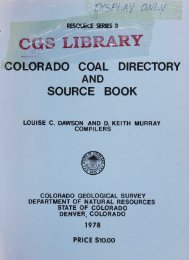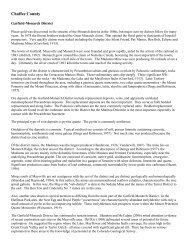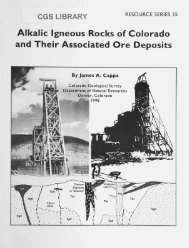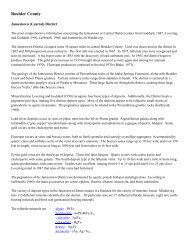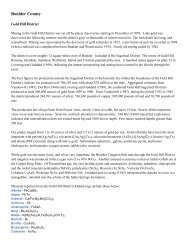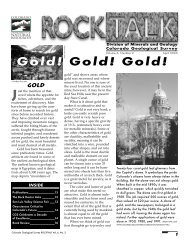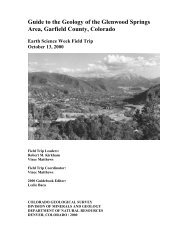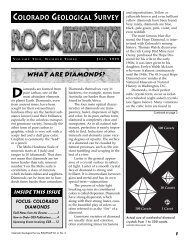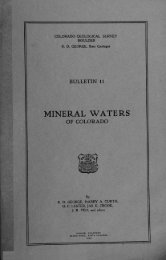Marble - Colorado Geological Survey
Marble - Colorado Geological Survey
Marble - Colorado Geological Survey
Create successful ePaper yourself
Turn your PDF publications into a flip-book with our unique Google optimized e-Paper software.
ock unit known as the Molas Formation. This<br />
formation, which has been mapped as being up<br />
to 50 feet thick southwest of the area, is missing<br />
in the Aspen-Conundrum area. Where lower<br />
Belden rocks are sufficiently exposed due to<br />
contact metamorphism, as at the Conundrum<br />
Creek property recrystallization and deformation<br />
have destroyed necessary indicators for determination<br />
of a lower Belden contact.<br />
The Belden Formation is of importance economically,<br />
as this is the zone of marble being<br />
considered in this report.<br />
IGNEOUS ROCKS<br />
Overview<br />
Laramide and Middle Tertiary age igneous<br />
rocks have been emplaced throughout the Elk<br />
Mountains in the form of dikes, sills, lacoliths,<br />
and plutons. Laramide age intrusive rocks of<br />
both mafic and felsic affinity occur predominantly<br />
as sills. Laramide igneous rocks described<br />
thus far in the Aspen area include hornblende<br />
quartz diorite, quartz porphyry, aplite,<br />
and aplite porphyry. All of these intrusive rocks<br />
have been recognized in the Conundrum Creek<br />
area. None of these rock types were mapped in<br />
the vicinity of the <strong>Colorado</strong> Highland <strong>Marble</strong><br />
quarry property by CGS. Middle Tertiary age<br />
(Oligocene) calc-alkalic igneous rocks comprise<br />
a number of large plutons and associated dikes,<br />
sills, and lacoliths. The major rock types are<br />
granodiorite, granodiorite porphyry, and hornblende<br />
porphyry. The Oligocene plutons have<br />
been emplaced along a regional zone of weakness<br />
(the Elk Range Thrust Fault) with which<br />
they are generally concordant. The plutons are<br />
also concordant with bedding in gross aspect,<br />
but occasionally cross-cut strata. Figure 3<br />
shows the outcrop pattern, and some structural<br />
relationships of the Oligocene plutons. The<br />
White Rock pluton is of particular interest<br />
because of extensive areas of associated contact<br />
metamorphism which have produced the<br />
marble and hornfels of the Conundrum valley<br />
(Bryant, 1979).<br />
White Rock Pluton<br />
The White Rock pluton outcrops in a roughly<br />
circular pattern in the southeastern part of the<br />
Elk Mountains. Rocks of the pluton make up<br />
the jagged peaks at the head of Castle Creek,<br />
part of Conundrum Peak, the ridge north of<br />
Hayden Peak, Keefe Peak, and the crest of the<br />
Elk Mountains at the head of East Maroon<br />
Creek. Major exposures of the pluton in the<br />
study area are the north ridge of Hayden Peak,<br />
a large mass on hill 12,146 between Cataract<br />
and Conundrum Creeks, and along the plane of<br />
the Elk Range Thrust which cuts the western<br />
side of the Vermont Placer on the west side of<br />
Conundrum Creek. Just north of the Vermont<br />
Placer claim, rocks of the White Rock pluton<br />
form the prominent cliffs on the west side of<br />
the valley.<br />
Rocks of the White Rock pluton are granodioritic.<br />
The granodiorite is white to gray rock<br />
composed mostly of plagioclase feldspar, with<br />
lesser amounts of quartz and potassic feldspar.<br />
Accessory minerals are biotite, hornblende,<br />
pyroxene, and magnetite. The pluton displays<br />
chemical variation with small areas of more<br />
mafic phases occurring at or near margins of<br />
the pluton.<br />
Country rocks at the contacts of the pluton<br />
lack chilled margins and are generally not deformed<br />
due to intrusion. An exception is rocks<br />
of the Belden Formation which are highly deformed<br />
near contact with White Rock plutonic<br />
rocks. Country rocks have been subjected to<br />
contact metamorphism, especially in areas<br />
where the intrusive contact is discordant.<br />
Exposures of the White Rock pluton south of<br />
the <strong>Colorado</strong>-Highland <strong>Marble</strong> Quarry contain<br />
substantial quantities of pyrite which is generally<br />
disseminated, but can occur as micro-fracture<br />
fillings or in large masses up to four inches<br />
in diameter (Figure 4). Where sulfides occur<br />
in the pluton, alteration is most pronounced.<br />
Fluid inclusion studies conducted by J.T. Nash<br />
and C.G. Cunningham, Jr. show this to be postmagmatic<br />
alteration which most likely occurred<br />
a million to a few million years after emplacement<br />
of the pluton. Also associated with this<br />
late stage alteration are mineralized fracture<br />
zones containing quartz and/or carbonate, and<br />
pyrite. Some of these zones are reported to<br />
9



